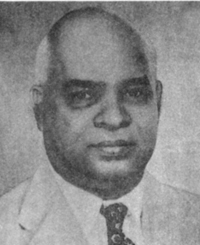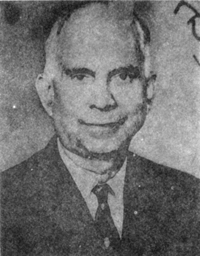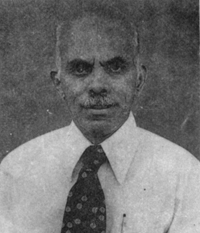|
(Continued from last fortnight)
The Postgraduate (PG) and Diploma courses were started at the Maternity Hospital in 1930. To provide extra facilities for PG teaching and research in medicine, the Government of India upgraded certain departments into PG Institutes in 1952, the three in Madras being the Institute of Obstetrics and Gynaecology, the Institute of Venereology and the Institute of Anatomy. The Institute of Ob & Gyn began functioning in September 1952 and Dr. R.K.K. Thampan, who was mainly responsible for this upgradation, was appointed its first Director.

Dr. R.K.K. Thampan

Dr. M.K. Krishna Menon

Dr. K. Bhaskar Rao
|
A May 22, 1957 report by Superintendent S. Abraham records, ‘During the year under review there were 11,112 confinements as against 9682 in 1954 and 8901 in 1953. The increased number goes to show that more and more of the public are realising the need for hospitalisation at the time of confinements and to avail of the facilities provided in this hospital to the public by the Government of Madras.’
It was during Dr. M.K. Krishna Menon’s 14-year tenure as the next Director that the Institute earned a name in this country and abroad as a centre of training and research in Ob & Gyn. Back in 1960, he was convinced that without a separate institute fully equipped and staffed for the purpose for which it was created, very little work could be done. He planned a big multistoried block for this purpose that was completed in September 1973. It accommodated a large auditorium, museum and library, besides several labs for work in reproductive endocrinology, immunology, human genetics, pathology, cytology etc. A student remembers how Dr. Menon often reiterated, ‘All PGs must live on the premises. You must talk, discuss, see, hear, and dream Ob and Gyn.” By his own example of hard work and constant study he kept aspiring doctors on their toes – night duty or not, all PGs assembled every morning for his morning rounds and clinics and afternoon case presentations. His former office is now occupied by the on-duty anesthetists!
Dr. Palaniappan, the only male student who joined the course in 1955, inspired “by a class of Dr. M.K. Krishna Menon”, and who followed the steps of Dr. K. Bhaskar Rao, remembers, “I’ve seen patients across cross-sections of society sideline all other hospitals and come to Egmore MH, travelling many miles to reach its portals. Only Englishwomen then used the services of the special ward. And the A-2 Ward, where septic cases were treated, was where the ultimate treatment for eclampsia evolved in the late 1950s under the supervision of Dr. Krishna Menon, who greatly encouraged male gynaecologists. Every case was treated as good clinical material. It was amazing that the Chiefs then would insist on a call even in the middle of the night if a patient was in labour! Initially there was some resistance to male gynaecologists but later the benefits of having men around who would attend late night calls, file FIRs, etc. overcame this.
“The Radiation Department at the MH was one of the earliest in the State. Dr. ALM was responsible for the founding of the Cancer Block. As house surgeons, we were trained at MH to apply radium needles in the early 1950s. Since this was the only Cancer Ward at the time, patients flocked here, but most generally came in very advanced stages. There was even a very useful file for PGs in the Labour Ward on ‘How to manage a patient from the time of reception to the time of delivery’. When Dr. Krishna Menon retired in 1972-73, it was the end of a golden era in Ob Gyn history.”
When a separate Children’s Hospital was started in 1960, the load at MH was reduced to only mainly neonatal paediatrics. In 1965, the Operation Theatres were airconditioned, and in 1973 the Family Planning Block with a 20-bed tubectomy ward and operation theatre was built.
A 1973 record notes, “Though the hospital has a bed strength of 528 and a daily census of over 800 inpatients, it still lacks a good medical records section so essential for a PG teaching centre. It is also in need of an OT complex, a good gyn inpatient block and a well knit OP service and telecobalt unit. Wards are badly overcrowded, and transport facilities (lifts and ramps) are unsatisfactory.”
The same year, Dr. ‘ALM’ (who by then had retired from service) conveyed his happiness at the new blocks being opened. “It was my privilege to have been on the staff in various capacities for over a quarter of a century. In view of its outstanding work the hospital was made one of the upgraded Departments by the Government of India to cater to the needs of the student population in the whole country. I hope and trust that the teaching imparted at the Institute of Ob and Gyn would attract students from all over the East, both at UG and PG levels, and that the Hospital will fulfil the highest standards as regards clinical work as well as the teaching imparted.”
In 1974, then Director K. Bhaskar Rao recorded, “Out of 532 beds, 244 are obstetric beds (including in the Caesarean ward), 240 are gynaec (two large post-operative wards), 20 for tubectomy and 28 beds for premature baby unit. Two separate labour wards to handle clean and septic labour cases with operative delivery room and an emergency operation theatre are attached. The Emergency Admission Ward has a small intensive care unit, also an isolation ward for infective cases.” The number of admissions during the year was 26,061 and deliveries 13,153!
By 1994, the number of deliveries had risen to 16,000, and it was considered “not only a maternity hospital, but also a complete super speciality hospital which caters to infertility work, departments of endocrinology with facilities for radio immuno assay, and department of medical genetics, the first in India.”
The hospital was “planning to have a computer,” it was tentatively announced in the 150th year souvenir released in February 1994. That year, Dr. A.B. Marikar, a former Superintendent of the hospital and at the time Director of Medical Services, Tamil Nadu, noted in the souvenir, “Even till 60 years ago, the Resident Medical Officers were men recruited from the same service. It was a time when ignorance, lack of environmental sanitation, resulting in anaemia, osteomalacia, tuberculosis, dysentery, etc. sapped the lives of mothers and ignorance carried off the babies. Maternal mortality was high due to obstructed and neglected labour and a trial of ineffective charms and potions and consultation with barber midwives or dais. Advice through husbands from learned vaids and hakims added to the toll of women’s suffering. The earliest reasonably qualified medical women belonged to Christian missions who came to India in 1872 after a long and tedious journey across the seas and oceans. With the MMC, the pioneer in admitting women to the Medical Course as early as 1875, one of the first batch of four women to pass the Certificate Course was Dame Marie Scharlieb (who later went on to establish the Victoria Caste and Gosha Hospital, later renamed the Kasturiba Gandhi Hospital for Women and Children). Most of their practical training was at this Maternity Hospital under Surgeon Branfoot.”
The gynaec wards were crowded with women who were delivering their twelfth or fifteenth babies, who had longstanding uterine and ovarian tumours, and who suffered from a variety of pelvic infections as consequences of criminal abortions. Most of the sufferers were young women and widows. “Gone are the days when internees had to witness a classical Caesarean section (a rarity, with hardly 20 cases in a year). A lower segment Caesarean section was unknown. A bell was rung to summon the sleeping internees to the theatre to witness the operation! With the increasing performance of lower uterine segment Caesarian section for increasing indications, perhaps the days may not be far away when the bell may toll again to summon internees to see a normal delivery which may become a rarity!” noted Dr. Marikar, tongue in cheek.
Dr. Prema Naidu remembers in the same 1994 record, “The main gate with double non-shutters enclosed entrances to the two OP departments on either side. The floor above housed the main officers and some of the Women House Officers’ Quarters. New patients were announced by a bell as they arrived at the Main Gate (complex) to alert the staff of the admission complex. Almost antrally situated in this layout is the fine Giffard School Building, and the well lit auditorium is entered from the lobby with its museum of pathological specimens. The galleries are in two halves with a space in the middle for projection purposes. A row of bookshelves housed a small library on the specialities. The great number of monsters in the museum jars has been the basis of several scientific papers. There was a clinical lab flanking the lobby on one side and the Women House Officers’ Quarters upstairs. Near the back gate was a building for men house officers. A tennis court was maintained nearby for officers to play during off duty hours.”
(To be concluded)
|